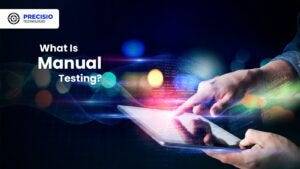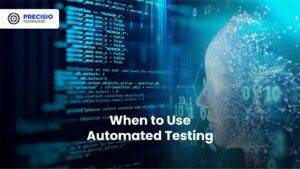#manual testing
Explore tagged Tumblr posts
Text
Automated Testing vs. Manual Testing: Which One is Right for Your Project?

Achieving high-quality, reliable software stands as a fundamental requirement in software development. Successful testing functions as an essential tool to discover faults and build performance capabilities that create better user experience outcomes. Two main testing methods dominate the field: automated testing and manual testing. The process of quality software assurance uses different testing approaches that demonstrate their own advantages as well as weaknesses according to specific project requirements and scenarios. We will explore the specifics to determine which testing process works best for your system development efforts.
1. What Is Manual Testing?

Manual testing involves a human tester manually executing test cases without using automation tools. Key Characteristics:
The methodology focuses its efforts on user interface together with usability and experience testing.
Human-centered applications where selection requires discretion include ad hoc testing and enumerative testing as well as examinations that need human evaluation.
Human performers are required during this approach; thus, it demands substantial time.
2. What Is Automated Testing?

Software performing automated testing executes test cases through workflows and helpers. Key Characteristics:
Efficient for repetitive and regression testing.
Users must spend money on tools along with developing custom scripts for testing.
Reduces human error.
3. Advantages of Manual Testing

Human Intuition: Software testing professionals can detect kernels through their human cognitive ability that automated tools cannot match. The observation and evaluation of visual elements runs more efficiently through human operatives instead of advanced tools.
Flexibility: This method suits exploratory testing specifically because there are no pre-determined scripts available.
Low Initial Investment: Running this approach does not need tool purchases or applications to develop automation frameworks.
Adaptable for UI/UX Testing: Running this approach does not need tool purchases or applications to develop automation frameworks.
4. Advantages of Automated Testing

Speed: Executes repetitive tests much faster than humans.
Scalability: The system proves most effective for extensive projects that need constant system updates.
Accuracy: When performing recurring actions, automated systems minimize the chances of human mistakes.
Cost-Efficient in the Long Run: Once established and implemented, the system demands costly investments but ensures continuous development expenses decrease over time.
Better for CI/CD Pipelines: Such testing technology connects various development pipelines that support agile and DevOps methodologies.
5. Disadvantages of Manual Testing

Time-Consuming: The manual performance of repeated tests leads to delayed completion of projects.
Error-Prone: Large applications contain tiny bugs that human testers commonly fail to detect.
Not Ideal for Scalability: The process of increasing manual testing needs additional testers to avoid cost escalations.
6. Disadvantages of Automated Testing

Initial Costs: Organizations must provide high financial resources to procure testing tools together with developing programming constructs.
Limited to Pre-Defined Scenarios: These testing approaches work poorly for handling exploratory or ad hoc testing.
Requires Maintenance: Test scripts need frequent updates when application changes occur.
Not Suitable for UI/UX Testing: Struggles with subjective user experience evaluations.
7. When to Use Manual Testing

Small Projects: The testing method proves beneficial at a low cost for small applications and provides quick assessments.
Exploratory Testing: Testing this approach benefits projects whose scripts have not been defined yet or need evaluation for newly added features.
Visual and Usability Testing: Performing assessments on interface components together with design features.
8. When to Use Automated Testing

Large Projects: Handles scalability for projects with frequent updates.
Regression Testing: Program testing becomes more efficient through automation since automated assessments perform multiple tests following each update process.
Performance Testing: The system performs efficient capabilities to conduct load testing and stress testing.
Continuous Development Environments: Agile progression and DevOps implementations need automation as a core requirement.
READ MORE- https://www.precisio.tech/automated-testing-vs-manual-testing-which-one-is-right-for-your-project/
2 notes
·
View notes
Text
#automation testing#manual vs automation#automation vs manual#manual testing#software testing services
2 notes
·
View notes
Text
QA & SOFTWARE TESTING - SPARK TECHNOLOGIES

As a world-class IT services provider with years of experience across various sectors globally. Spark Technologies delivers the business IT solutions you need to enhance efficiency, add value, and reduce costs. We design, develop, implement, manage, and optimize access to systems and information, addressing your business processing, application, and infrastructure needs.
click here for more
2 notes
·
View notes
Text
#quality control#software#software testing#manual testing#software test#test#testing#functional#function test#@photo#@photography#photos#picture#joke#shutterstock#mystery#solangelo#nico di angelo#met gala 2023
4 notes
·
View notes
Text
How AI and Machine Learning Are Shaping the Future of QA Automation
AI and Machine Learning (ML) are revolutionizing QA automation by making testing smarter, faster, and more efficient. Traditional automation focuses on repetitive tasks, but AI-driven testing adds predictive capabilities, helping teams deliver higher-quality software with less effort.
Self-Healing Test Scripts:
AI helps create self-healing scripts that adapt to changes in the application’s UI or structure, reducing test maintenance.
Predictive Analytics:
ML algorithms analyze historical QA automation test data to predict failures and identify high-risk areas, enabling teams to focus on critical issues.
Intelligent Test Generation:
AI can generate and prioritize test cases automatically based on application behavior and user interactions, improving test coverage.
Defect Detection and Root Cause Analysis:
AI-powered tools detect anomalies, classify bugs, and suggest fixes, accelerating the debugging process.
Natural Language Processing (NLP):
NLP-based tools allow testers to create test scripts using plain English, reducing the need for extensive coding knowledge.
As AI and ML continue to evolve, they will transform QA automation from reactive to proactive testing, ensuring faster releases with fewer bugs. Embracing these technologies is key for organizations aiming to stay competitive in the fast-paced software industry.
#test automation#automation testing tools#software testing tools#qa automation#manual testing#qa tools#qa testing tools#qa automation tools#no code test automation#penetration testing software#ai testing tools
0 notes
Text
Both approaches have distinct advantages and challenges in the debate between manual and automated testing. Manual testing is invaluable for exploratory testing, user experience assessments, and situations that require human intuition and creativity. It is particularly beneficial for small-scale projects with limited or evolving testing scope. However, manual testing can be time-consuming, prone to human error, and less efficient for repetitive tasks.
0 notes
Text
Why You Can't Skip Manual Testing in Your Development Process!

Among the most critical steps in software development, always working is the greatest requirement. However, how do developers test whether everything actually works properly then release an application or a website for users? Testing makes that possible. Testing aids in detecting bugs or errors before the software reaches the current public.
There are two forms of testing, and they include; manual testing and automated testing. Automated testing is the use of tools that run tests automatically; it is not a substitute for every type of testing though useful. In this form of testing, the actual checking of software occurs by real people, or testers, by hand in the same way a user would use it.
In this blog, we’ll explain how manual testing works and why it’s still a vital part of software development.
What is Manual Testing?
It has also been called manual testing-- the process of testing anything step-by-step, without any support of automation tools. The tester will keep clicking his way to the buttons, and forms to fill in, and checking if everything's working. The concept behind it is to try finding out bugs (problems) and reporting to the development team, so they could correct before its software release.
For example, if you’re testing a new mobile app, a manual tester would check if buttons work, if the app crashes, or if something doesn't load as it should. Testers also look for anything that doesn’t seem right or is hard to use.

Why is Manual Testing Important?
Human Perspective The most important benefit of manual testing is that it involves real people. Testers may think like users; they might try using the software in ways that a computer cannot. For example, they might not do everything just as they are being told. This means they could click on things at random, enter weird text, or skip steps. Manual testers can search for issues that may come up in the operation of the users, who might do things differently from normal. Automated tests, because they are scripted, miss them.
I believe this test would miss one thing for instance, if a user clicks the same button several times within a short period of time. Maybe application freezes or even crashes, but automatic test would not have been able to reproduce such because it does not check for such random behavior; manual tester may identify the problem.
Exploratory Testing Manual testers can go and explore the software without any kind of check list of tasks being followed. This technique is referred to as exploratory testing. Along with just proving whether certain things work, they can experiment by doing different things in order to find out what happens. In this way, they often discover bugs that were not anticipated or planned for.
For example, the tester may open the app, tap here and there and hit "back" while loading some page. In that way, they may establish errors that were not identified in simple testing.
Checking User-Friendliness (Usability Testing) Another very crucial aspect related to manual testing is that, whether or not the software is user-friendly. If the tester manually interacts with the app or website, he can point out if the design is confusing or hard to navigate. In this way, it could find whether the buttons are too small to click or if one cannot find how to sign up.
Automated tests can always test if a button works, but they cannot tell if a button's size or position is confusing to a real human. Here is where manual testing really catches fire. Testers can give valuable feedback on whether the software is easy to use and understandable.
Simulating Real-World Scenarios opposing, it is through manual testing that people are able to mimic a real user who intends to actually use the application. Hence, very straightforwardly, they can test and see how things will go on another device, browser, or even a slower connection.
For example, how the web page behaves on a mobile and on a tablet, and on the desktop computer. Alternatively, run the test using other browsers-chrome, Firefox, or Safari. They can even test the application with a slow internet connection, a battery nearly depleted, and all the usual real-world scenarios that could have thrown up issues well hidden from automated tests.
Providing Feedback The manual testers don't only find the bugs but go further and give useful feedback to the development teams. When they identify a problem, they report it, including how steps may eventually fix the issue. Testers can suggest improvements which could make the app design better, speed up, or eliminate fuzzy features.
The feedback loop is a way for developers to learn how users will use the software and how to fix their efforts.

How Manual Testing Fits into the Software Development Process
Manual testing usually happens in different stages of the software development process:
During Development: The testing team starts testing early, although all parts of the program are not at all developed. For example, they may test only to see if logging-in works or if it can create a new account.
Before Release: As the software approaches the end of the development stage, testing now manifests high-level and detailed checks. They look for bugs, errors, and usability malfunctions. It is during this stage that the tester could be involved with acceptance tests in the event that the computer program meets the requirements intended before the inception of the development of the computer program.
After Release: They're also going to be looking for bugs even after the software has been released to the public. Users may experience problems, and then the testers could have to test those problems themselves to help the developers fix them. Probably, they would also test updates and new features to make sure that nothing that works yet breaks.
Manual Testing vs. Automated Testing
While both types of testing are important, they serve different purposes:
Automated Testing: Automated testing well suits using for not often changing things like this login button: does it always work. In such tests, it is easy to repeat very speedily, with a lot of saving of time in large projects.
Manual Testing: It is better to have situations requiring human judgment undergoing manual tests. The tester can be creative, try various things, and observe small issues that the automated test may easily miss. In fact, regarding the user experience of checking if the application is easy to use or if the design is very clear, manual testing is favorable.
Most software projects use a combination of both types of testing. Automated testing can monitor so-called basic but repetitive tasks, whereas manual testing is mainly around more complex scenarios and stuff that really needs a human touch.
Conclusion
Manual testing during the whole software development will ensure the fact that the software will do what it is anticipated to do. Though possibly quicker, brilliant for checking repetitive tasks, but manual testing adds value to areas where human intuition, creativity, and judgment come into play; hence, a concealed bug, as manifested by manual testers, plus an opinion of whether the software is user-friendly or not and circumstances that resemble real conditions under which the software should be strong.
In this, the automated testing will cover all the basic functions, so the manual testing ensures that the product is polish and user-friendly, good for use in real applications. And if put together, then these approaches can yield high-quality and dependable applications, which meet the expectations of users as well as deliver an extraordinary experience. Visit Eloiacs to find more about Software Testing.
0 notes
Text
Agile Advisor: The UAE's Reliable Software Testing Consultancy for Improving Quality Assurance
Ensuring the operation and quality of your applications is crucial in the fast-paced world of software development. Agile Advisor, a top software testing consultancy in the United Arab Emirates, can help. With a firm grasp of industry standards and a dedication to quality, Agile Advisor is committed to providing organizations with comprehensive testing solutions that help them meet their quality assurance objectives. Agile Advisor is a standout option for businesses looking for excellent software testing services. We have a group of skilled experts specializing in various testing approaches, such as functional and manual testing. Our strategy is customized to each client's exact requirements, guaranteeing that your product satisfies requirements and surpasses user expectations. Agile Advisor, a well-known software testing firm in the United Arab Emirates, is dedicated to providing unmatched testing services that complement your company's goals. Our functional and manual testing proficiency enables us to provide customized solutions that improve performance and quality.

An essential part of the software development lifecycle is still manual testing. Our knowledgeable testers at Agile Advisor carefully examine your apps to find any possible problems that automated testing might overlook. Our manual testing services are Exploratory Testing: To guarantee a flawless user experience, our testers investigate the program to find usability problems. Usability testing: We evaluate your software's usability and offer suggestions to improve user satisfaction. Regression testing: We ensure that current features continue functioning flawlessly as upgrades and modifications are made. Agile Advisor ensures comprehensive coverage and subtle insights that lead to a refined final product by prioritizing manual testing. The quality of your software can make or break your company in today's cutthroat market. Software with adequate testing can result in good user experiences, lost profits, and tarnished reputations. You are investing in the dependability and success of your apps by working with Agile Advisor.
Functional testing is essential to ensure that your program operates as intended. We use various methods in our functional testing services to ensure every feature works as it should. Unit testing is among the functional tests conducted by the Agile Advisor, which establishes the foundation for quality assurance by testing individual components to ensure appropriate operation. Integration Testing: To guarantee smooth communication and integration, our staff looks at how different parts of your application work together. System testing: We verify that the integrated software system satisfies the criteria. Our thorough functional testing procedure reduces the risks connected with software deployment and detects flaws early. Our testing services support Boost Performance: Ensure your program functions well in various scenarios. Cut Expenses: To avoid expensive post-release fixes, find and address problems early in development. Increase User Contentment: Provide a well-designed product that satisfies users' requirements and expectations. To learn more about our all-inclusive testing solutions and how we can assist you in reaching your objectives, get in touch with Agile Advisor right now. Allow us to collaborate with you to develop outstanding software that makes a difference in the marketplace.
#softwaretestingconsultancy#manualtesting#functionaltesting#useracceptancetesting(uat)#qualityacceptancetesting(qat)#software testing consultancy#manual testing#functional testing#user acceptance testing#quality acceptance testing#uat#qat
0 notes
Text
Choosing the Right Approach: Manual vs. Automated Testing for Shopify Apps

The debate between manual vs. automated testing for Shopify apps is a crucial consideration for enterprise-level businesses. As Shopify applications grow in complexity, selecting the right testing strategy can significantly influence the quality, efficiency, and overall success of your e-commerce solutions. Recent statistics indicate that businesses adopting a balanced testing approach can achieve a 40% reduction in post-launch issues and a 35% increase in customer satisfaction. This guide delves into the nuances of manual and automated testing for Shopify apps, providing executives and decision-makers with the insights needed to make informed quality assurance choices.
Understanding Manual Testing for Shopify Apps
Manual testing remains a vital part of the quality assurance process for Shopify apps, offering unique benefits that automated methods cannot replicate. This human-centric approach involves testers executing test cases without the assistance of automation tools.
Advantages of Manual Testing
Intuitive User Experience Evaluation: Human testers provide subjective feedback on usability, which is essential for customer-facing applications.
Flexibility in Test Execution: Manual testing allows for immediate adjustments to test scenarios, accommodating unexpected situations or edge cases.
Cost-Effective for Smaller Projects: For apps with limited features or infrequent updates, manual testing can be more economical than investing in automation infrastructure.
Exploratory Testing Capabilities: Skilled testers can discover issues through exploratory testing, identifying problems that rigid automated scripts may overlook.
Challenges of Manual Testing
Time-Consuming for Complex Applications: As Shopify apps become more intricate, manual testing can become increasingly labor-intensive.
Potential for Human Error: Relying on human testers introduces the possibility of oversight and inconsistency.
Difficulty in Replicating Complex Scenarios: Some challenging test scenarios, especially those involving high loads or multiple concurrent users, are hard to replicate manually.
Best Practices for Manual Testing
To maximize the effectiveness of manual testing for Shopify apps, consider these best practices:
Develop comprehensive test cases covering all critical user journeys.
Employ skilled testers with expertise in e-commerce and Shopify.
Implement a structured approach to test case management and execution.
Regularly rotate testers to bring fresh perspectives on the app's functionality.
As Sarah Johnson, a leading Shopify app QA consultant, notes, "While automation is crucial for scaling testing efforts, the insights gained from manual testing are invaluable for ensuring a polished, user-friendly Shopify app experience."
The Power of Automated Testing for Shopify Apps
Automated testing has transformed the Shopify app development landscape, providing scalability and consistency that manual testing alone cannot achieve. This method utilizes specialized tools and scripts to execute predefined test cases automatically.
Advantages of Automated Testing
Increased Test Coverage and Efficiency: Automated tests can rapidly cover numerous scenarios, significantly boosting overall test coverage.
Consistency and Reproducibility: Automated tests execute the same steps precisely each time, eliminating the variations common in manual testing.
Support for Continuous Integration and Deployment: Automated tests can easily integrate into CI/CD pipelines, offering rapid feedback on code changes and facilitating frequent releases.
Cost-Effectiveness for Repetitive Testing: Although initial setup costs may be higher, automated testing becomes increasingly cost-effective over time, especially for large-scale applications with regular updates.
Challenges of Automated Testing
Initial Investment Requirements: Establishing an effective automated testing environment necessitates upfront investments in tools and skilled personnel.
Maintenance of Test Scripts: As the app evolves, automated test scripts require updates, which can be time-consuming.
Limited Detection of Usability Issues: Automated tests may miss subtle usability problems or unexpected scenarios that human testers might catch.
Best Practices for Automated Testing
To harness the full potential of automated testing for Shopify apps, consider the following best practices:
Select the right automation tools that integrate well with the Shopify ecosystem.
Categorize test cases for automation based on importance and execution frequency.
Implement a robust test data management strategy.
Consistently review and update test scripts to maintain their efficiency.
John Smith, CTO of a leading e-commerce solutions provider, emphasizes, "Automated testing is not just about speed; it's about creating a reliable, repeatable process that can keep pace with the rapid development cycles of Shopify apps."
Striking the Right Balance: Integrating Manual and Automated Testing
A comprehensive approach to testing Shopify apps typically combines both manual and automated methods. This blended strategy allows businesses to capitalize on the unique advantages of each method while mitigating the drawbacks of relying solely on one.
When to Use Manual Testing
Exploratory Testing: Ideal for exploring new features or investigating reported issues, especially when the reproduction steps are unclear.
Usability Testing: Manual testers can assess the app’s UI, UX, and overall accessibility.
Ad-hoc Testing: For quick evaluations of specific features or bug fixes, manual testing proves more efficient.
Acceptance Testing: Final user acceptance testing benefits from a human touch to ensure the app meets business requirements and user expectations.
When to Leverage Automated Testing
Regression Testing: Automate recurring tests to verify that recent updates haven't disrupted existing functionality.
Performance and Load Testing: Use automated tools to simulate high traffic and stress test the app.
Cross-browser and Cross-device Testing: Automate tests across different browsers and devices to ensure consistent functionality.
Data-driven Testing: For cases requiring testing with multiple datasets, automated testing is highly effective.
Implementing a Hybrid Approach
Risk-Based Testing Strategy
Focus both manual and automated efforts on key functionalities, prioritizing them based on their significance to business operations.
Continuous Feedback Loop
Utilize insights from manual testing to refine automated test scripts.
Specialized Team Roles
Create teams with expertise in both manual and automated testing, promoting collaboration and knowledge sharing.
Adaptive Testing Process
Continuously assess and adjust the balance between manual and automated testing based on evolving requirements.
Emily Chen, a Shopify app development expert, advises, "The key to successful Shopify app testing lies not in choosing between manual and automated testing, but in skillfully combining both approaches to create a comprehensive, efficient testing strategy."
Measuring the Success of Your Testing Strategy
To validate the effectiveness of your Shopify app testing strategy, establish key performance indicators (KPIs) and continually assess the outcomes.
Key Metrics to Track
Defect Detection Rate: Monitor the number and severity of defects identified during testing versus those reported post-launch.
Test Coverage: Measure the percentage of app features and code included in your testing efforts.
Time-to-Market: Track how your testing approach affects app development and release cycles.
Customer Satisfaction Scores: Analyze user ratings and feedback to gauge the real-world impact of your testing efforts.
Return on Investment (ROI): Evaluate cost savings and efficiency gains achieved through your testing strategy.
Continuous Improvement
Regularly review these metrics to refine your testing approach, which may involve:
Adjusting the balance of manual and automated testing.
Investing in new testing tools or methodologies.
Providing additional training for your testing team.
Enhancing test case design and prioritization.
Through ongoing evaluation and refinement of your testing strategy, you will ensure the efficiency and effectiveness of your Shopify app development lifecycle, aligning with your broader business objectives. This continuous improvement process enables you to adapt to market demands and technological advancements, keeping your e-commerce solutions at the forefront of performance and reliability.
Upgrade Your Shopify App Testing with Oyecommerz
Are you ready to optimize your Shopify app testing strategy and deliver outstanding e-commerce solutions? Oyecommerz is here to assist you in navigating the complexities of manual and automated testing for enterprise-level Shopify apps.
Don’t let inadequate testing undermine the success of your Shopify apps. Contact Oyecommerz today for a comprehensive assessment of your testing needs and take the first step toward delivering flawless, enterprise-grade Shopify applications.
Conclusion
Choosing between manual and automated testing is not an either decision rather, it’s about finding the right balance that utilizes the strengths of both methods. By understanding the intricacies of manual vs. automated testing for Shopify apps, implementing best practices, and continually refining your testing strategy, you can ensure the delivery of high-quality, reliable Shopify apps that meet the rigorous standards of enterprise-level businesses.
0 notes
Text

🚀 Ready to Become a Full Stack Testing Pro? 🚀
🖥️ Join us for an exclusive Full Stack Software Testing Training at eMexo Technologies on 30th Sept at 10:00 AM! Get hands-on experience with the latest tools and techniques for testing. Plus, we’re giving you a MASSIVE 40% OFF to kickstart your journey into the tech world! 💥
⏳ Limited Seats – Don't miss out on this career-boosting opportunity! 💼
📅 30th Sept 2024 🧭 10.00 AM ( IST )
Format: Classroom & Online Training
Contact Us For More Info:
📞 Phone: +91 9513216462
🌐 Website: https://www.emexotechnologies.com/
#software testing#manual testing#seleniumtesting#automationtesting#techeducation#testing#career growth#careerdevelopment#emexotechnologies#bangalore#electroniccity#traininginstitute#education#learning
0 notes
Text
Selenium Online Training Overview

Selenium Online Training is designed to provide participants with a comprehensive understanding of Selenium. Learn Selenium Online Training skills with real experts, either in live classes with videos or without videos, whichever suits you best. Selenium an open-source framework for automated testing of web applications. Selenium supports various programming languages and browsers, making it a versatile tool for testing web-based applications across different environments. This course covers the key concepts, techniques, and best practices for automated testing using Selenium.
Description
This Selenium Online Training begins with an introduction to automated testing and the importance of Selenium in the software development lifecycle. Participants will learn about Selenium WebDriver, Selenium Grid, and the Selenium IDE. The course covers topics such as locating web elements, performing actions, handling dynamic content, and creating robust test scripts. Practical examples, hands-on projects, and real-world scenarios will be used to reinforce theoretical concepts. Learn Selenium Online Training skills with real experts
Course Objectives
The primary objectives of the Selenium Online Training course are as follows:
Introduction to Automated Testing: Provide an overview of automated testing and its significance in ensuring software quality.
Introduction to Selenium: Understand the role of Selenium in automating the testing of web applications.
Selenium WebDriver: Explore Selenium WebDriver, the core component for browser automation in Selenium.
Locating Web Elements: Learn techniques for identifying and locating HTML elements on web pages for interaction.
Performing Actions: Understand how to perform various actions on web elements, such as clicks, inputs, and selections.
Handling Dynamic Content: Explore strategies for handling dynamic content and asynchronous operations in Selenium.
Selenium Grid: Introduce Selenium Grid for parallel execution of test scripts across multiple browsers and environments.
Testing Framework Integration: Learn how to integrate Selenium with testing frameworks like TestNG or JUnit.
Page Object Model (POM): Understand the concept of the Page Object Model for creating maintainable and scalable test scripts.
Cross-Browser Testing: Explore techniques for conducting cross-browser testing to ensure compatibility across different browsers.
Prerequisites
Selenium Online Training Pre-Requisites:
Basic understanding of software testing concepts.
Familiarity with at least one programming language (e.g., Java, Python).
Knowledge of HTML and CSS.
Understanding of web browsers and their developer tools.
Awareness of test automation principles and frameworks.
Experience with using and navigating integrated development environments (IDEs).
Course Curriculum
Manual Testing
Demos
Introduction of Manual Testing
Testing Methods / Techniques
Level of Testing
SDLC
What is SDLC
Water fall Model
Prototype Model
Evolutionary Model or Incremental Model
Spiral Model
V-Model
Agile Methodology
Difference QA and QC
What is the role of the QA
What is the role of the QC
STLC
Test Planning
Test Development
Test Execution
Result Analysis
Bug tracking
Reporting
Closed Out
Test Scenarios
Entry and Exit Criteria
What is mean by Test Scenarios
How to Design Test Scenarios
Design Guidelines To write Test Scenarios
Test Cases
Entry and Exit Criteria
What is mean by Test Cases
How to Design Test Cases
Design Guidelines To write Test Cases
Test Execution – Bug Reporting
Guide lines of Test Execution
Steps to execute test cases
Bug Life Cycle
How to log the defect
How to Verify the Defect Status
How to Close the Defect
Difference between Defect ,Bug, Error, failure
Severity and Priority
How we are consider Severity
Types of Severity
Types of Priority
JIRA
How to Install the Jira
How to Create Sprint
How to Release Sprint in agile process
How to log the Defect to Particular Developer
Zephyr Scale
How to install Zephyr scale for Jira
How to create the test cases in zephyr scale
How to execute the test cases in zephyr scale
Additional Concepts
Entry Criteria and Exit Criteria
Test plan vs Test Strategy
Test Design Techniques
What is Exhaustive testing
Bug Leakage vs Bug Release
RTM and DTM
Manual testing Terminology
Testing Principal
Types of Testing
Build Acceptance testing
Re Testing
Regression Testing
Smoke Testing
Sanitary Testing
Static Testing
Dynamic Testing
Compatibility Testing
Usability Testing
Integration Testing
Alpha Testing
Beta Testing
Security Based Testing
Installation Testing
Privilege Testing or fire wall testing
Port Testing
Monkey testing
Gorilla testing
Spike testing
Load testing
Exploratory testing
Ad hoc Testing
End- End Testing
Core Java
Introduction
Introduction
History
Platform Dependency
Independency
Installation
Download and Install
Path Settings
Manual Execution
IDEs
Programming Elements
Introduction to Variables and Methods
First Application
Classes
Objects
Contexts (Static and Instance)
Naming Conventions
API Documentation
Main Method (Object Class Methods to Be Discussed Later On)
Data Types
Primitive Types
Reference Types
Limits
Type Casting
ASCII and UNICODE
Operators
Arithmetic
Assignment
Relational
Logical
Conditional
Shif
Bitwise
Compound Assignment
Control Statements
Conditional Control Statements with Flowcharts and Programs
Loop Control Statements with Flowcharts and Programs
Branching Statements
Access Modifiers
Private
Package
Protected
Public
Wrapper Classes
String Conversions
Boxing, Unboxing
Auto Boxing, Auto Unboxing
Fields of Wrapper Classes
Packages
Introduction
Pre-defined Packages
Custom Package Creation
Manual Compilation of Package Files
util Package
Random Class
Scanner Class
Subpackages
Custom Subpackage Creation
Class Loader Subsystem
Fully Qualified Name
Duplicate Classes
OOPS
Introduction
'this' Keyword
'this()' Method
Encapsulation
POJO Class
Inheritance
Introduction
IS-A Relation
Types of Inheritance
Object Creation in Inheritance
Super
'super' Keyword
'super()' Method
Object Initialization in Inheritance
'this' vs 'super'
Final
Final Class
Final Method
Final Variables
Final Constructor
Abstraction Classes
Abstraction
Abstract Methods
Abstract Classes
Object Creation of Abstract Class
Object Initialization
Static and Abstract
Abstract and Final
Interfaces
Introduction
'implements' Keyword
Relations among Classes, Interfaces, and Abstract Classes
Upcasting
Polymorphism
Introduction
Method Overloading
Method Overriding
Exception Handling
Introduction
Hierarchy
Errors and Exceptions
Handling Exception
'try', 'catch', 'multi catch'
'throw', 'throws'
Custom Exceptions
String Handling
Introduction
Mutability, Immutability
String Methods
String Classes
String Buffer, String Builder
String Tokenizer
Reflection API
'Class.forName()'
Dynamic Loading
Class Information
Methods Information
Arrays
Introduction
One-Dimensional Arrays
Arrays Class
Two-Dimensional Arrays
Multi-Dimensional Arrays
Collection Framework
Introduction
For Each Loop
Generics
Collections Hierarchy
List Interface
ArrayList
Vector
Linked List
Programs
Queue Interface
LinkedList
Deque
PriorityQueue
Set Interface
Hashtable
HashSet
LinkedHashSet
TreeSet
Map Interface
HashMap
LinkedHashMap
TreeMap
Comparator
Selenium
Introductions of Selenium
What is Mean by automation testing
Difference between Selenium and UFT
What is Selenium RC and GRID
What is the Web Driver
How to download Selenium Jar files
How to download Selenium Drivers
How to Organize the drivers
How to Configure the Selenium project
Selenium Working Mechanism
List of HTML Elements
Locators In Selenium – Eight Locators
Launching Browsers in Selenium
How to execute test cases in chrome and firefox and Edge browsers
Methods in Selenium
How to use Scanner Class in Selenium
How to use Conditions in Selenium
How to use Abstract class in Selenium
How to use Constructor in selenium real time
How to Automate Google Search box
Negative testing and positive testing
Automate login using four Sets
Parallel Execution in Selenium in different ways
Multi Browser Testing
Execute the Test case in user’s in our favorite browser
How Take the Screen Shot in Selenium
Handling Drop Down
Methods in Select Class
Browser Navigation Commands
Handling Alerts
Handling Frame
How to handle the Multi windows in selenium
Synchronization in Selenium
How to handle the webpage by using Actions
Actions in Selenium
How to search By using Action
How send the data by using Actions
How to Click on Any Element By using Actions
How to do Mouse over Action
How to Click on expected element in Search bar
How to Right click
How to Drag and drop
How to Double Click
How to do Multiple Selector
How to handle the Window popup
How to handle the web page by using JSE
JavaScript Executor in selenium Web Driver
How to Get the title By using JSE
How to Scroll Top to Bottom and Bottom to Top By Using JSE
How to Refresh By using JSE
How to Send the Data by Using JSE
How to Click Hiding Element
How to Click the Element By using JSE
Types of Exceptions in Selenium
TestNG
Introduction of TestNG
How to Download TestNG
How to create testing class
How to execute TextNg Class without main Method
How to Execute Multiple Test cases
How to Execute Testcases Based on priority
How to excute Group Testcases
Order of Annotations
How to Execute Parell execution
How to Do the Cross browsing
How Write the Real Time Scripts By using TestNG
How to create .xml
How to create parameter
What is the Data provider with examples
How to find passed Test cases in TestNG
How to provide Enable false
How to provide Description
What is the diff between @Test and @beforetest
Clear explanation about all Annotations
How to find failed test cases In TestNG
Tools
Maven
What is the Maven
How to Create the Maven Project
What is use of Maven in Real time
What is the folder structure in Maven
How to add the dependencies in maven
What is the POM
How to execute maven and how to resolve the maven errors
GitHub
What is the GIt Lab uses of Git
How to Install Node JS
How to Install npm
How to Install Git
How to create git Account
How to store the Frame works or any application information
How to pull the frame work
How to update any data in git
How to update data in central Repository
Jenkins
What is the Jenkins and use of the Jenkins
How to Install Jenkins
What is the CICD
How to Create the Jenkin Project
How to Create the Jobs
How to Execute the Jobs
What is role of the DevOps in Jenkins
Log4j
What is Log4j
Advantages of Log4j
Steps to implement Log4j
CUCUMBER (BDD) Framework
What is the Cucumber
How to create cucumber project
How to add the dependencies
How to validate the All Dependencies
What is the Feature file
How to create and where we need to create future file
What is Scenario and Scenario outline
What is the Feature and Background Key
What is the Step definition
How to map feature file in Step Definition
What is Gherkin Language
What is Dryrun and Monochrome
What is JSON format and how to print that format
What is the Test Runner and how to create the Test Runner
What is the Cucumber option’s
How to Execute the Cucumber project in Test Runner
How to Install Naturls for cucumber
How to install cucumber Plugin
API - Testing
What is the API
How to install Postman
How to Create workspace and collections
What is the collections and Requests
Types of API method
What is the difference between REST and SOAP
How to create the variable in global
Types of HTTPS status codes
What is the difference between HTTP and HTTPS
What is the Web Services and API
What is the URI
What is the difference between URL and URN
What is the Domain path and path parameters Query path
How to validate the API in real time
How to execute API’s in command promote
How to execute Collection level API’s
How to create token
How to use the token in API
How to create the token in collection level
API-Rest Assured
Rest assured installation
Examples Of Rest assured Program
Database Testing
What is the Database testing
How to install the MySQL and configuration
How to create the table and insert and delete and update
How to get the Single column values
What is the Primary key forenkey
How to connect the Data base through Eclipse
How to get the Data base information from in Eclipse
Data Driven Frame Work
How to create the Data Driven framework
How to download Apach poi jar files
How to install the POI
What is the sxml and xml
How to read the data from Excel sheet
How to write the data from excel
Who can learn this course
Selenium Online Training Course is suitable for a diverse range of individuals, including:
Quality Assurance (QA) Engineers: Professionals in QA or testing roles looking to enhance their skills in automated web testing.
Software Testers: Individuals responsible for testing web applications seeking to automate repetitive testing tasks.
Developers: Programmers interested in incorporating automated testing into their software development process.
Automation Test Engineers: Those specializing in test automation and wanting to learn Selenium for web application testing.
DevOps Professionals: Individuals involved in the DevOps pipeline interested in automated testing for continuous integration.
Students and Graduates: Individuals pursuing degrees in computer science or related fields with an interest in software testing.
Anyone Interested in Automated Testing: Enthusiasts and professionals curious about leveraging Selenium for automated testing.
The Selenium Online Trainingis designed to cater to both beginners and individuals. Selenium Training by Experts
selenium online training : https://nareshit.com/courses/selenium-online-training
0 notes
Text
Top software testing companies
Top software testing companies (promise that something will definitely #happen or that something will definitely work as described) improve software quality and #performance, help #organisations optimise applications, satisfy strict standards, and provide perfect user #experiences. They also offer a variety of services, such as #automated, performance, #security, and mobile testing.
Visit our website: www.precisetestingsolution.com
Contact : 8447088848
0 notes
Text
Manual Testing
In manual testing, testers execute test cases manually without the use of automation tools. This basic testing technique involves human effort to identify errors, issues, or defects within a software program.
Read More: Complete Guide for Manual Testing Process!
0 notes
Text
At HikeQA, we specialize in elevating the quality and performance of SaaS and mobile applications. Our dedicated QA services are tailored to meet the unique demands.
0 notes
Text
Software Quality Dimensions
Any software development organization aims to achieve high software quality. Software quality is complex and has many aspects, contrary to popular belief that software quality is just the number of bugs. The ISO/IEC 25010 standard gives eight dimensions from which to evaluate software quality. Every aspect is essential either from the customer's perspective or from the development organization's.
The Eight Dimensions of Software Quality
The following dimensions are as per the ISO/IED 25010 software quality model:
1. Functional Suitability
Functional suitability is about how well the software operates for the end-users. High-quality software will have no missing functionality, a low defect rate, and quickly solve end-user problems.
How to evaluate:
Integration testing
Regression testing
Acceptance testing
UI automation
2. Performance
Performance refers to how well the software performs under various workloads. High-quality software will be scalable, have low response times, high throughput, and optimal hardware and software utilization.
How to evaluate:
Stress testing
Page load times
Soak testing
3. Usability
Usability refers to how easily end-users can use and benefit from the software. A highly usable software is easy to learn and use, is accessible to users with special needs, protects end-users from errors, and is pleasing to the eye.
How to evaluate:
User acceptance testing
Website engagement and conversion monitoring
Real user monitoring
Customer satisfaction survey
4. Reliability
Reliability refers to a software system's resistance and resilience to malfunctions. A reliable software works consistently over long periods, has high availability, is fault-tolerant, and recovers quickly from crashes.
How to evaluate:
Soak testing
Load testing
Regression testing
5. Compatibility
Compatibility refers to the software's ability to coexist and work with existing software and hardware. A highly compatible software will work seamlessly across various hardware, operating systems, and screen sizes.
How to evaluate:
Cross-browser testing
UI automation
6. Maintainability
Maintainability refers to how quickly you can modify your code to meet new requirements. High-quality code is modular, reusable, analyzable, adaptable, and easily testable. Complex code is less maintainable. However, poorly written and undocumented code is even worse.
How to evaluate:
Lines of Code (LOC)
Static code analysis
Cyclomatic complexity evaluation
Peer review
7. Portability
Portability refers to how easily you can move the software to another execution environment. High-quality portable code can adapt to evolving software and hardware platforms. It is easy to install and requires minimal external dependencies.
How to evaluate:
Setting realistic environments for testing.
Automating installation/uninstallation testing
Platform-specific UI and regression testing
8. Security
Security refers to the vulnerability of the software to malicious attacks and unintended end-user actions. Highly secure software is resistant to cyber-attacks. It also has a high degree of authenticity, confidentiality, non-repudiation, and accountability.
How to evaluate:
Vulnerability scanning
Malware scanning
Ethical hacking
0 notes